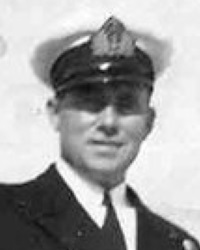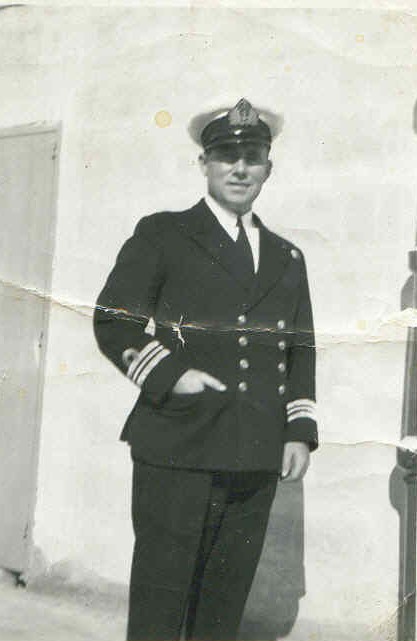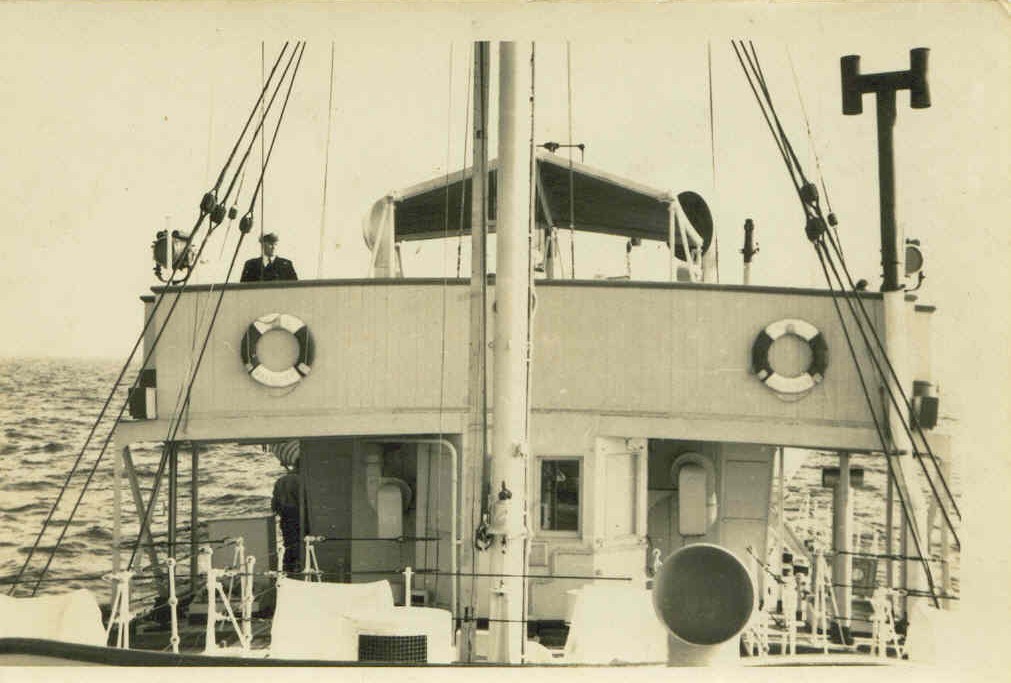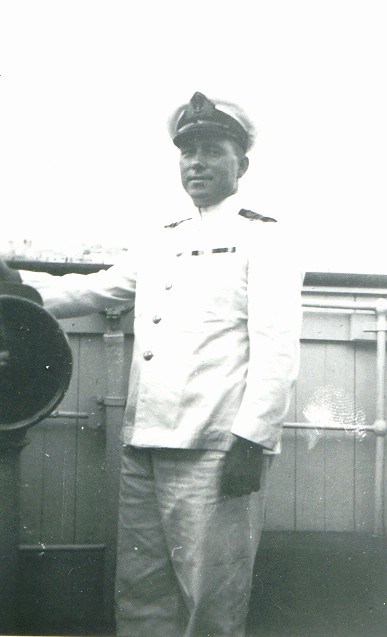Frederick Charles Hard

Place of birth: Brighton, Sussex, England
Parents: Frederick and Edith Hard
Wife: Doris Hard
Previous occupation: Scholar
Service: Royal Navy
Rank: Petty Officer
Service Number: JX132944
Joined Hood First time: 23rd April 1932 (Able Seaman)
Left Hood First time: 30th August 1934 (Able Seaman)
Joined Hood Second time: 8th September 1936 (Acting Leading Seaman)
Left Hood Second time: 12th May 1939 (Petty Officer)
Biographical Information:
This article was written by Gary Andrews, the nephew of Fred Hard.
 From an early age, Fred Hard showed great affinity for the sea. As a young boy, he built two canoes and the sea became was his playground.
From an early age, Fred Hard showed great affinity for the sea. As a young boy, he built two canoes and the sea became was his playground.
Fred was born on the 4th of March 1913, into a family who resided in the seaside town of Brighton, England. The family business was a butcher's shop and was well known in the area.
As he grew older, his interest in boats grew and for about three years he coxed the "Racing Four 'A'" crew of the Brighton Cruising Club. At the same time, he sailed with Ernie Hale; racing his craft off the coast of Brighton.
On the 11th of March 1929, just seven days after his sixteenth birthday, he joined the Royal Navy as a boy seaman. He was sent to the training establishment H.M.S. St Vincent, in Gosport, Hampshire. From this initial training, he was then posted to the coal-burning battleship H.M.S. Emperor of India. Though fully operational, the ship was partly manned by boys to give them a good seagoing experience. At the time Fred joined the Royal Navy, the main rig was white canvas suits. These suits could get rather cold while the sailors scrubbed decks at Scapa Flow in the Scottish winter. The boys were not allowed to wear sea boots, which no doubt added to their discomfort especially on a freezing morning.
On being rated to Ordinary Seaman, he was drafted to the 16 inch gun battleship H.M.S. Nelson. While he served on Nelson, he visited the West Indies and passed through the Panama canal to meet the American fleet at Bilbao. It was noted that the canal's locks were 110 feet wide and Nelson was 107 feet 6 inches; a tight fit!
It was during this cruise that his swimming ability came to the fore and he was selected to both the water polo and swimming teams. Promotion was quickly followed and he climbed the ranks again attaining Able Seaman. A new ship was on the horizon in the shape of the Scott class destroyer H.M.S. Montrose. Again, promotion was forthcoming and he was passed for promotion to Leading Seaman on his eighteenth birthday; quite young for those days. Shortly after this, his Captain arranged a special draft to the "Mighty Hood." His Captain considered Fred for this position as he believed he should have experience on a larger ship. Hood carried naval instructors giving Fred the chance to qualify educationally for future promotions. The schooling aspect was pretty much hard graft for Fred as he, like a lot of us, wasted a lot of time in his formative years; such is life!
At about this time, he was earmarked for selection for the "Mate" promotion scheme. To be considered, Fred would have to obtain the necessary five first classes at one sitting, in the then called Higher Educational Tests. This, he was not to achieve but he did qualify for warrant rank.
After careful consideration between specializing in gunnery, torpedoes or seamanship, Fred decided on the latter.
When the Hood re-commissioned, Fred spent a short time in Victory barracks before being drafted to the battleship H.M.S. Revenge in the Mediterranean fleet. To take him there was the converted merchant ship H.M.S. Ark Royal which was fitted with an aircraft catapult on the foredeck.
Life in the naval Mediterranean fleet consisted of a battleship, battlecruiser squadron, and destroyer flotillas. This concentration of ships and men promoted great sporting rivalry between the divisions. Fred represented the ship in swimming, water polo, hockey and rugby; the latter no doubt providing a great many bruises and cuts!
Fred was in the Med for just over two and a half years and in 1936 H.M.S. Revenge returned to England. After a short spell in barracks, Fred was posted back to H.M.S. Hood. In his own words, she was one of the "best looking ships in the Royal Navy," a statement echoed by many. The "Mighty Hood" was always a fine sporting ship and apart from Fred's usual sports, he added cross country running to his roster of physical activities.
Fred also made quite a name for himself sailing Hood's 27 foot whaler in the many regattas the ship took part in. In fact he got a crew together and entered an open whaler's race at the Royal Malta Yacht Club which they promptly won and so won the first of many trophies for the Hood.
During this commission on Hood, the ship became involved with humanitarian aid during the Spanish Civil War. In his writings, Fred recalls the results of heavy bombing and the transferring of refuges.
In 1937, as an electrician for Hood's B turret, Fred had a nasty accident involving one of his arms. Fred did not elaborate on the incident, but did note it involved a 15 inch shell and the hydraulic rammer. The injury was serious and broke his arm, as well as severed arteries and muscle tissue. Still conscious, he managed to climb down the 25 foot vertical ladder, onto the turret barbette, and proceed through the mess decks to the sick bay. When he arrived, medical personnel hastily applied a tourniquet before he promptly passed out through lack of blood. An emergency operation was swiftly carried out but after three days gangrene set in. The Captain at the time decided to leave the fleet and steam at a fast 28 knots to take Fred to Bighi Hospital in Malta; presumably for his arm's amputation. As luck would have it, the physician aboard Hood had administered the drug Prontosil which in 1937 was a fairly new drug. By doing this, the physician arrested the gangrene's development. The surgeon in the Bighi hospital, a Commander Keating, decided to try and save Fred's arm. After three long months in the hospital, the arm was saved and Fred was discharged. Fred then took passage onboard H.M.S. Queen Elizabeth to rejoin Hood at Spithead for the Coronation Review.
 At the outbreak of the war in 1939, Fred was rated up to Petty Officer shortly before the Hood came back to England for re-commission. He had also passed the seamanship exam for Warrant Rank. Early in 1939, Fred left the Hood for the last time to start a long course to qualify as a Boatswain. In April of that year, Fred married Doris Parsons whom he had been courting since 1926. Fred and Doris and had been engaged to for eight years, five of those years being separated by Fred's service in the Mediterranean.
At the outbreak of the war in 1939, Fred was rated up to Petty Officer shortly before the Hood came back to England for re-commission. He had also passed the seamanship exam for Warrant Rank. Early in 1939, Fred left the Hood for the last time to start a long course to qualify as a Boatswain. In April of that year, Fred married Doris Parsons whom he had been courting since 1926. Fred and Doris and had been engaged to for eight years, five of those years being separated by Fred's service in the Mediterranean.
In January 1940, Fred was finally commissioned as Boatswain and was promptly appointed to serve on H.M.S. Challenger; a survey ship. Tasks for this important ship of the line included surveying approaches to homebase harbours for the laying of loop mine defenses and surveying Londonderry which was a growing Naval base.
Also, the crew of the Challenger surveyed the main fjords of Iceland in anticipation of the Marines landing there and to find suitable bases for the air force. After accomplishing these tasks, Challenger was due a refit at the East India docks, in London.
Challenger's next task was to survey the approaches of Bathurst West Africa which was destined to be a refueling port for convoys, etc. While there, the problem of the French fleet at Dakar was developing. Having completed the harbour survey, Challenger was ordered 150 miles up the Gambia River in case it would be necessary to land troops up river to attack Dakar from the rear. As things turned out, this was not necessary with the unfortunate bombing and shelling of the French ships.
Challenger returned to England in 1942, and Fred was then appointed Boatswain in charge of the seamanship school, in Portsmouth. There he remained for two years until he was selected for accelerated promotion to Lieutenant, which involved going to sea again. Fred joined the converted merchant ship H.M.S. Ausonia which was virtually a dockyard repair ship. As the ship carried riggers and sailmakers, it was a good ship for a Boatswain. Further experience was also gained on board H.M.S. Devonshire. Fred was promoted to Lieutenant in 1946 and was appointed to H.M.S. Obdurate, a destroyer from the Portsmouth flotilla. Obdurate was employed mainly for torpedo firing trials off the coast of Weymouth and Portland.
In January 1947, Fred was appointed to H.M.S. Howe (battleship) as an instructional officer. Later he transferred to H.M.S. King George V for the same duties. There he remained until 1949 before being moved to the target destroyer H.M.S. Onslaught as First Lieutenant working out of Rothesay.
This ship's assignment was mainly for officers who were qualifying to command submarines. Each day the officers went in a submarine to "attack" Onslaught who in turn would try to detect and attack the submarine. As the officers gained experience, the attacks became more intense and realistic. Although no depth charges were dropped, grenades were dropped from the bridge to simulate actual explosions trying to get as close as possible to the submarine. Fred briefly commanded Onslaught during its transfer stage as it was being sold to a foreign power.
The next stage in Fred's naval career was the "highlight," as he put it. The Admiralty were looking for officers to take over command of the Fleet tugs which during the war had been commanded by Master Mariners from the Merchant service. So in 1951, Fred became First Lieutenant of the Meditteraean fleet tug H.M.S. Brigand. The main job of these tugs in this area was to tow targets and accompany the fleet on cruises, etc. One notable incident on Brigand was when she went to the assistance of SS Benledi which was on fire. Together with the salvage ship, "Sea Sailor" was brought back to Malta. Not long after this, Fred was again promoted. This time to Lieutenant-Commander in 1950.
 In October 1951, Fred was appointed to command Brigands sistership H.M.S. Marauder and was frequently working between Malta, Gibraltar and other locations. Once, he had to tow the fully laden oil tanker "Esso Fawley" from the Suez Canal to Bari, Italy in order to off load the oil. Then later from Bari to Palermo to have a new rudder fitted which was lost in the canal. This was a particularly arduous tow for all concerned and took three weeks all told.
In October 1951, Fred was appointed to command Brigands sistership H.M.S. Marauder and was frequently working between Malta, Gibraltar and other locations. Once, he had to tow the fully laden oil tanker "Esso Fawley" from the Suez Canal to Bari, Italy in order to off load the oil. Then later from Bari to Palermo to have a new rudder fitted which was lost in the canal. This was a particularly arduous tow for all concerned and took three weeks all told.
Once back in Malta, the commander-in-chief, Lord Louis Mountbatten, came aboard to congratulate the ship's company in person and to thank them personally.
Another interesting story Fred mentioned was concerning the practice of using Bible and other quotations in signals; a practice most probably frowned upon today. One day while towing a target for the ship commanded by Prince Philip, Fred received the signal "regret delay owing to radar defect." Fred replied with Hebrews Chapter 13, verse 8 which interpreted reads, "Jesus Christ, the same today and forever." Fred remembered the reply being from Corinthians Chapter 4 verse 8, "We are troubled on every side yet not distressed, we are perplexed, but not in despair." No doubt an interesting use of the good book!
Early in 1953, Fred returned to England and was appointed to a larger tug, the H.M.S. Warden which had a length of 208 ft, a beam of 36 feet and a draft of 16 feet. Its crew numbered thirty-six including Fred as Captain and three officers normally Boatswains. These powerful ships were run by 4,000 horsepower twin diesel engines connected to a single propeller shaft capable of 16 knots with a cruising range of about 57 days. One particular large tow in 1953, was the towing of a pontoon 200 feet by 60 feet from Sherness to Nassau in the Bahamas. The pontoon was part of the chemical warfare trials that are now banned yet are very topical in today's news, however, were highly secret in the fifties. This tow, in bad weather, took thirty-one days.Another notable tow was the submarine depot ship H.M.S. Montclave from the Clyde to Portsmouth. Unfortunately, on this tow Fred and his men were caught in a force 10 gale off Lands End. The tow parted and several crew were injured during the recovery. After landing the injured men on the Scilly Isles, the tow was finally completed.
 Fred's records indicate that 1955 and 1956 were very busy times. Among other towing jobs, he towed the battleship King George V twice, the aircraft carriers, Illustrious, Indefatigable, Hermes, and floating docks nos.19 and 26.
Fred's records indicate that 1955 and 1956 were very busy times. Among other towing jobs, he towed the battleship King George V twice, the aircraft carriers, Illustrious, Indefatigable, Hermes, and floating docks nos.19 and 26.
In 1956, Fred was appointed to the Admiralty on the Director of Boom Defence and Marine Salvage Staff, which involved the job of allocating tugs for various duties around the world.
In May 1957, Fred retired from the Royal Navy and then took up the position of Harbourmaster for Chichester. Fred thoroughly enjoyed this work with 1,700 yachts and 17 miles of waterways to control. During his twenty-one years as Harbourmaster, Fred rescued, helped, salvaged or merely advised many, many boats and ships during his service. Fred finally retired at the age of sixty-five on the 4th of March 1978, living not far from the sea at Chichester; his old stomping ground. He continued to be very active doing some gardening, and his new hobby of woodturning.
Fred died in October 2002, and the above biography was based on notes he had written just a few years ago. He was very active in the Hood Association attending reunions and various meetings. Naturally, my family knew some history of Fred's naval career and now, with his biography, we found out a lot more. It is my privilege and honor to share it with you. If you would like to comment on this life story, add commentary, or even perhaps knew him, please email me at visionon80@hotmail.com. I would love to hear from you.
My enduring memory of my Uncle Fred was as a small boy being taken for boat rides on his launch. I remember coasting the waterways of Chichester with Fred at the helm, and sometimes, being allowed to steer the launch myself, though never really being able to command the helm like my Uncle.
History of ships served in and ratings held:
| Date From | Date to | Ship | Rating | Source |
| 12th March 1929 | 26th September 1929 | St. Vincent | Boy 2nd Class | ADM362/28 |
| 27th September 1929 | 8th May 1930 | St. Vincent | Boy 1st Class | ADM363/563 |
| 9th May 1930 | 1st September 1930 | Emperor of India | Boy 1st Class | ADM363/563 |
| 2nd September 1930 | 2nd January 1931 | Emperor of India | Ordinary Seaman | ADM363/563 |
| 3rd January 1931 | 1st December 1931 | Nelson | Ordinary Seaman | ADM363/563 |
| 2nd December 1931 | 4th January 1932 | Nelson | Able Seaman | ADM363/563 |
| 5th January 1932 | 22nd April 1932 | Victory II (Montrose) | Able Seaman | ADM363/563 |
| 23rd April 1932 | 30th August 1933 | Hood | Able Seaman | ADM363/563 |
| 31st August 1933 | 12th January 1934 | Victory II (Montrose) | Able Seaman | ADM363/563 |
| 13th January 1934 | 22nd November 1935 | Revenge | Able Seaman | ADM363/563 |
| 23rd November 1935 | 17th January 1936 | Revenge | Acting Leading Seaman | ADM363/563 |
| 18th January 1936 | 7th September 1936 | Victory I | Acting Leading Seaman | ADM363/563 |
| 8th September 1936 | 22nd November 1936 | Hood | Acting Leading Seaman | ADM363/563 |
| 23rd November 1936 | 31st August 1937 | Hood | Leading Seaman | ADM363/563 |
| 1st September 1937 | 31st August 1938 | Hood | Acting Petty Officer | ADM363/563 |
| 1st September 1938 | 12th May 1939 | Hood | Petty Officer | ADM363/563 |
| 13th May 1939 | 24th January 1940 | Victory I | Petty Officer | ADM363/563 |
| 25th January 1940 | Promoted to acting Bosun | Petty Officer | ADM363/563 |
Additional Photos |
 A cartoon of Fred and some shipmates. |
No known memorials
Sources
Commonwealth War Graves Commission
'Register of Deaths of Naval Ratings' (data extracted by Director of Naval Personnel (Disclosure Cell), Navy Command HQ, 2009)
Gary Andrews, e-mail 21 Oct 2002
Noel Eaton, e-mail 21 March 2002
